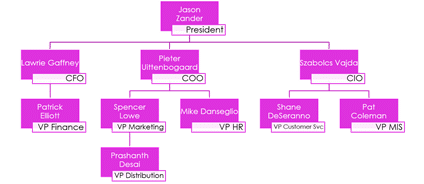Organizational Charts Shouldn’t Be a Secret
I recently heard this conversation that (no offense) struck me as odd. It was about organizational charts.
First, in case you didn’t know, organizational charts (aka org charts) are a visual depiction of the organization’s structure. Basically, it outlines who reports to whom. Here’s an example of a SmartArt org chart from Microsoft PowerPoint:
The reason companies use org charts is to quickly and clearly see hierarchical structure. This is helpful in company communications, job analysis, workforce planning, change management, and organizational restructuring.
Back to the conversation. I heard someone say that their company’s organizational chart was only available to senior management. Employees weren’t permitted to see the company’s org chart. It seems to me that if the purpose of an org chart is to create a visual that helps with communication and planning, then why wouldn’t everyone have access to it? Wouldn’t it benefit both management and employees?
Organizational charts document what already exists in a company. By keeping an org chart secret, isn’t that the same as saying, “We don’t want employees to understand our organizational structure.”? As you can tell, I’m struggling with this one. I do understand that there are times when we’re not ready to share why we’re using an org chart. An example might be during a restructuring. But withholding an org chart and withholding what the org chart is being used for are two totally different things.
Organizational charts aren’t just a management tool. They are a company tool that everyone can benefit from.
8